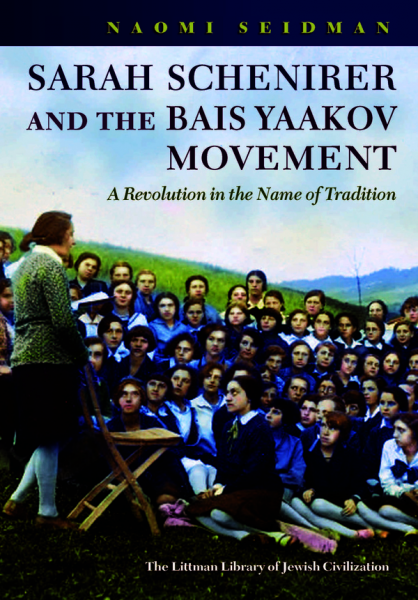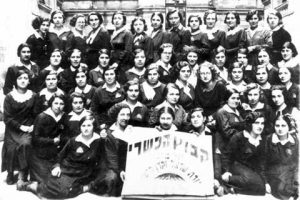When asked about the path she’s taken to become a leading scholar of contemporary Jewish thought, Bible translation and gender and sexuality, Naomi Seidman tells the story of her father, a survivor of the Second World War who spoke both French and Yiddish.
“After the war,” she says, “my father found himself in Paris where he got a job as an unofficial liaison between Jewish refugees and the French authorities. One day the authorities called him and said a group of refugees had arrived at the train station without papers — come quick!
“At the train station, he saw the French police with the refugees and there was pandemonium. So, my father, speaking Yiddish, said to the refugees, ‘Yidn, don’t be afraid. We will get you papers. Don’t worry, the police won’t harm you. They’re not Nazis.’ And immediately, the refugees calmed down.
“One of the policemen asked my father, ‘What did you say to quiet them down?’ And in French, my father said, ‘I told them, don’t worry. Every free man has two homelands: his own and France. You’ve arrived at the birthplace of liberty. Liberté, égalité, fraternité.’ At which, the police began wiping away patriotic tears.”
Seidman heard this story growing up and the fact her father had different messages for the French police and the Jewish refugees prompted her to ponder language and translation, as well as the dialogue between the Jewish and non-Jewish worlds.
Those thoughts — along with learning Yiddish as a child and a great love of literature — were steps on a career path that eventually led to the Graduate Theological Union in Berkeley, where she was the Director of the Richard S. Dinner Center for Jewish Studies and the Koret Professor of Jewish Culture. And ultimately, to the University of Toronto, where she is a Chancellor Jackman Professor of the Arts in the Department of Religion and the Centre for Diaspora and Transnational Studies.
Upcoming book explores Bais Yaakov movement

Seidman is currently looking forward to the publication of her most recent book, A Revolution in the Name of Tradition, a history of the Bais Yaakov movement and the creation of schools to provide a rigorous education in Jewish orthodoxy to girls.
Bais Yaakov was founded in 1917 by seamstress Sarah Schenirer in response to the defection of young Jewish women from the Orthodox community to Christianity, Communism and secularism, in part because they were being denied the education that was part of every Jewish boy’s upbringing. Soon after the school began, graduates branched out to start their own schools throughout Eastern Europe. Today, there are hundreds around the world and hundreds of thousands of graduates.
“Many people say the movement rescued Jewish orthodoxy,” says Seidman, a Bais Yaakov graduate herself. “It could not have carried on without the dedication of young women. It provided a way for young women to be passionately Jewish.”
The publication of A Revolution in the Name of Tradition does not mark the end of Seidman’s work on the history of the movement, but rather the start of a new type of scholarship for her. While researching the book, she discovered a collection of songs associated with the schools, which she and collaborators are bringing to life through performances and recordings. They are also gathering oral histories and archival materials through events and the Bais Yaakov Project website.
“My desire is to break out of the traditional academic approach,” Seidman says, “and to enrich my research life with community connections and more. That’s now possible for me as a Chancellor Jackman professor and because of the value the University of Toronto places on connections between scholarly work and the world.”
Naomi’s presence at U of T is simply transformative.
Seidman received encouragement for this approach from Anna Shternshis, Director of the Anne Tanenbaum Centre for Jewish Studies at U of T, who herself worked with musicians and artists to record Holocaust-era, Yiddish-Soviet songs. The album has garnered a 2019 Grammy nomination for Best World Music album.

“Naomi’s presence at U of T is simply transformative,” says Shternshis. “Her Bais Yaakov Project brings to life stories of this important institution both to the scholarly community and the general public, in a way that excites everyone. This scholarship is the way to embrace the future of humanities. I cannot be more proud that Naomi chose U of T to be her intellectual home.”
As she makes the Faculty of Arts & Science at U of T her new intellectual home, Seidman is also making Toronto home for herself and her family. “My son is a brand new freshman at U of T,” she says. “And we’re living together — the new professor and the new student! His current passion is pinball and he’s internationally ranked. So my knowledge of Toronto consists of places where you can play pinball or places where you talk about religion. Someone should do a sitcom about us!”
Of her new home, Seidman says, “There’s so much happening here, but I’m starting to make connections. The way you make a city or university in your mind, the way it slowly builds — it’s a dialogic process. It’s a lot like the way we learn a language.”

